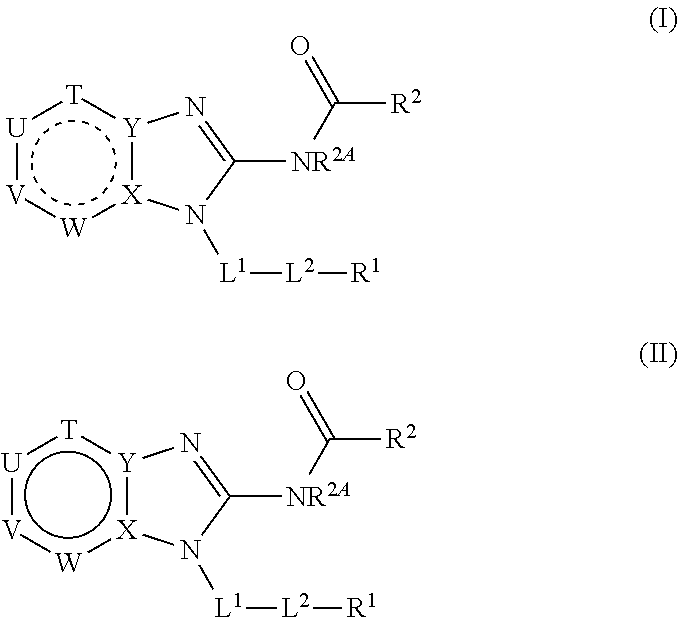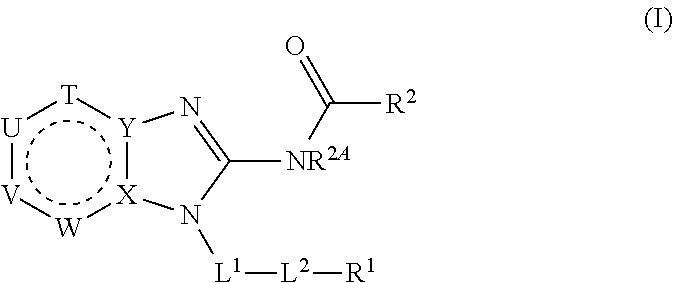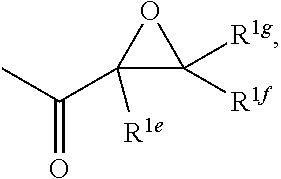Benzimidazoles for use in the treatment of cancer and inflammatory diseases
a technology of benzimidazoles and cancer, applied in the field of benzimidazoles for use in the treatment of cancer and inflammatory diseases, can solve the problem of slowing down the acquired resistance to the treatmen
- Summary
- Abstract
- Description
- Claims
- Application Information
AI Technical Summary
Benefits of technology
Problems solved by technology
Method used
Image
Examples
example 1a
[0592]The biological activity of a test compound was determined using cell proliferation assays. The activity against wild-type ERBB1 was determined using A431 human epidermoid carcinoma cells (ATCC) and human epidermal keratinocytes, neonatal, or HEKn cells (ATCC). The activity against mutant ERBB1 was determined using HCC827 human NSCLC adenocarcinoma cells (ATCC), which has a deletion of E746-A759 in exon 19. The activity against a drug-resistant mutant ERBB1 was determined using H1975 human NSCLC adenocarcinoma cells (ATCC), which has the T790M mutation in-cis with the L858R mutation.
[0593]A431 cells were grown in DMEM (Invitrogen) supplemented with 10% FBS (Lonza), 1% penicillin-streptomycin, and 2 mM glutamine (Invitrogen). HEKn cells were grown in EPILIFE® (Invitrogen) supplemented with HKGS (Invitrogen). HCC827 and H1975 were cultured in RPMI1640 supplemented with 10% FBS (Lonza), 1% penicillin-streptomycin, and 2 mM glutamine (Invitrogen). Cells were...
example 2a
[0596]The Z'-LYTE® biochemical assay is a fluorescence-based, coupled-enzyme assay based on the differential sensitivity of phosphorylated and non-phosphorylated peptides to proteolytic cleavage. A peptide substrate for a kinase is labeled with two fluorophores, one at each end, to form a FRET pair.
[0597]
TABLE 1Inhibition of Cell ProliferationGI50Cmpd.HCC827H1975HEKnA431Calu3A1AACAA2AADBA3AACDA4AACCA5AACCC16AAAAC19AABAC20AAAAD12AACBD14AACAA13-AAABAB1-AAADCC1-AAACCC2-AAACCC11-AAADCErlotinib7.043812200Afatinib1.0120 211.4CO-1686321092500
[0598]In the primary reaction, the kinase transfers the gamma-phosphate of ATP to a single tyrosine, serine, or threonine residue in the synthetic FRET-peptide substrate. In the secondary reaction, a site-specific protease recognizes and cleaves non-phosphorylated FRET-peptides. Cleavage disrupts FRET between the donor and acceptor fluorophores on the FRET-peptide, whereas uncleaved, phosphorylated FRET-peptides maintain FRET....
example 3a
[0601]Binding of an ALEXA FLUOR® conjugate or “tracer” to a kinase is detected by addition of a Eu-labeled anti-tag antibody. Binding of the tracer and antibody to a kinase results in a high degree of FRET, whereas displacement of the tracer with a kinase inhibitor results in a loss of FRET. An inhibitory activity of a compound is thus determined from the extent of the FRET signal loss. Inhibition of ITK and TEC kinases by a test compound is determined in the presence of 1% DMSO.
PUM
 Login to View More
Login to View More Abstract
Description
Claims
Application Information
 Login to View More
Login to View More - R&D
- Intellectual Property
- Life Sciences
- Materials
- Tech Scout
- Unparalleled Data Quality
- Higher Quality Content
- 60% Fewer Hallucinations
Browse by: Latest US Patents, China's latest patents, Technical Efficacy Thesaurus, Application Domain, Technology Topic, Popular Technical Reports.
© 2025 PatSnap. All rights reserved.Legal|Privacy policy|Modern Slavery Act Transparency Statement|Sitemap|About US| Contact US: help@patsnap.com



